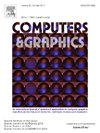CGLight:基于改进型卷积混频器和 GauGAN 的有效室内光照度估计方法
IF 2.5
4区 计算机科学
Q2 COMPUTER SCIENCE, SOFTWARE ENGINEERING
引用次数: 0
摘要
在增强现实(AR)系统中,照明一致性是将虚拟对象与真实场景无缝集成的关键因素。高动态范围(HDR)全景图像被广泛用于准确估计场景照明。然而,生成环境地图需要复杂的深度网络架构,而这种架构无法在内存空间有限的设备上运行。为了解决这个问题,本文提出了一种有效的光照度估算方法 CGLight,它能从单个有限视场(LFOV)图像预测 HDR 全景环境图。我们首先设计了一个 CMAtten 编码器来从输入图像中提取特征,该编码器以较少的模型参数学习球谐波(SH)光照表示。在光照参数的指导下,我们训练生成式对抗网络(GAN)来生成 HDR 环境贴图。此外,为了丰富光照细节并减少训练时间,我们特别引入了颜色一致性损失和独立判别器,在提高计算效率的同时考虑了颜色属性对光照估计任务的影响。此外,我们还利用预测的环境贴图对虚拟物体进行了重新照明,验证了 CGLight 的有效性,其在灰色漫射球中的均方根误差和角度误差分别为 0.0494 和 4.0607。大量的实验和分析表明,CGLight 实现了室内光照度估计精度和资源效率之间的平衡,以比 ViT-B16 模型少近 4 倍的模型参数获得了更高的精度。本文章由计算机程序翻译,如有差异,请以英文原文为准。
CGLight: An effective indoor illumination estimation method based on improved convmixer and GauGAN
Illumination consistency is a key factor for seamlessly integrating virtual objects with real scenes in augmented reality (AR) systems. High dynamic range (HDR) panoramic images are widely used to estimate scene lighting accurately. However, generating environment maps requires complex deep network architectures, which cannot operate on devices with limited memory space. To address this issue, this paper proposes CGLight, an effective illumination estimation method that predicts HDR panoramic environment maps from a single limited field-of-view (LFOV) image. We first design a CMAtten encoder to extract features from input images, which learns the spherical harmonic (SH) lighting representation with fewer model parameters. Guided by the lighting parameters, we train a generative adversarial network (GAN) to generate HDR environment maps. In addition, to enrich lighting details and reduce training time, we specifically introduce the color consistency loss and independent discriminator, considering the impact of color properties on the lighting estimation task while improving computational efficiency. Furthermore, the effectiveness of CGLight is verified by relighting virtual objects using the predicted environment maps, and the root mean square error and angular error are 0.0494 and 4.0607 in the gray diffuse sphere, respectively. Extensive experiments and analyses demonstrate that CGLight achieves a balance between indoor illumination estimation accuracy and resource efficiency, attaining higher accuracy with nearly 4 times fewer model parameters than the ViT-B16 model.
求助全文
通过发布文献求助,成功后即可免费获取论文全文。
去求助
来源期刊

Computers & Graphics-Uk
工程技术-计算机:软件工程
CiteScore
5.30
自引率
12.00%
发文量
173
审稿时长
38 days
期刊介绍:
Computers & Graphics is dedicated to disseminate information on research and applications of computer graphics (CG) techniques. The journal encourages articles on:
1. Research and applications of interactive computer graphics. We are particularly interested in novel interaction techniques and applications of CG to problem domains.
2. State-of-the-art papers on late-breaking, cutting-edge research on CG.
3. Information on innovative uses of graphics principles and technologies.
4. Tutorial papers on both teaching CG principles and innovative uses of CG in education.
 求助内容:
求助内容: 应助结果提醒方式:
应助结果提醒方式:


